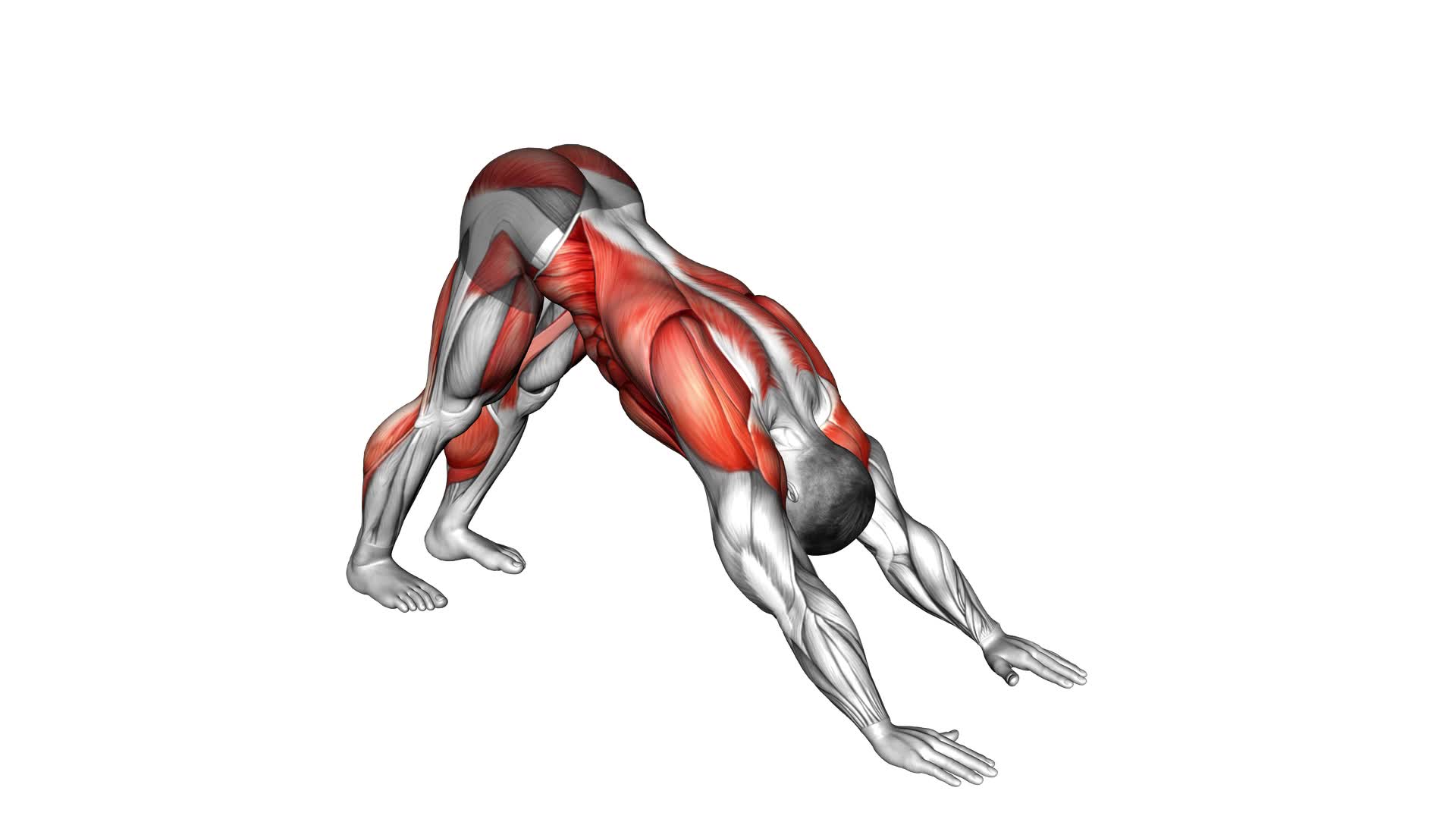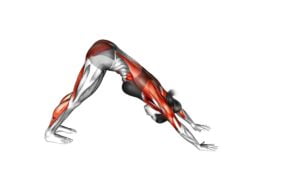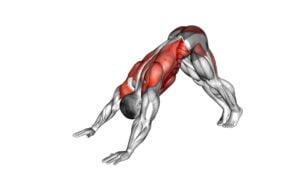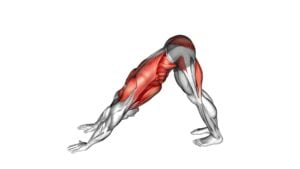Downward Facing Dog – Video Exercise Guide & Tips

Are you looking to improve your yoga practice and strengthen your body? Look no further than Downward Facing Dog!
Watch This Exercise Video
This video exercise guide and tips will help you perfect your alignment, avoid common mistakes, and deepen your pose. With the help of step-by-step instructions and demonstrations, you'll be able to reap all the benefits this pose has to offer.
Get ready to feel energized, balanced, and ready to take on the day!
Key Takeaways
- Downward Facing Dog strengthens and stretches multiple areas of the body.
- Proper alignment is important in Downward Facing Dog to avoid injuries and maximize benefits.
- Modifications and variations can be used to make the pose easier or more challenging.
- Common mistakes to avoid include collapsing shoulders, lifting or dropping the head, and sinking into the wrists.
Benefits of Downward Facing Dog
Experience the numerous benefits of Downward Facing Dog, a compound yoga pose that strengthens and stretches multiple areas of your body.
This pose isn't only a great way to improve flexibility, but it also targets and strengthens the upper body.
Downward Facing Dog offers a deep stretch for your hamstrings, calves, and arches, allowing for increased flexibility in these areas. As you lengthen your spine and reach your heels towards the ground, you'll feel a gentle pull that helps to release tension and tightness in your muscles.
In addition to improved flexibility, Downward Facing Dog is an excellent pose for strengthening your upper body. As you press your hands into the mat and engage your core, you'll feel your arms, shoulders, and chest working to support your body weight. This not only builds strength but also helps to improve posture and stability.
By regularly practicing Downward Facing Dog, you'll notice increased flexibility in your muscles and a stronger upper body. This pose is a perfect addition to your yoga routine, allowing you to reap the many benefits it offers.
Proper Alignment in Downward Facing Dog
To achieve proper alignment in Downward Facing Dog, you should focus on positioning your body correctly to maximize the benefits of the pose. Here are some alignment tips and variations for beginners:
- Start on your hands and knees, with your hands shoulder-width apart and your knees hip-width apart.
- Press your palms into the mat and lift your hips up, straightening your legs as much as possible.
- Keep your heels grounded and your toes pointing forward. If your hamstrings are tight, you can bend your knees slightly.
- Lengthen your spine by reaching your tailbone towards the ceiling and pressing your chest towards your thighs.
- Engage your core muscles by drawing your navel towards your spine.
Remember, proper alignment is crucial in Downward Facing Dog to avoid strain on your wrists, shoulders, and lower back.
As a beginner, it's important to listen to your body and modify the pose as needed. You can use props like blocks or a folded blanket under your hands to reduce the distance between the floor and your hands.
Don't be discouraged if you can't achieve the full expression of the pose right away. With practice and patience, you'll gradually improve your alignment and experience the many benefits of Downward Facing Dog.
Modifications and Variations for Downward Facing Dog
Try out different modifications and variations to enhance your Downward Facing Dog pose.
Downward Facing Dog is a versatile yoga pose that can be modified to suit your individual needs and abilities. If you're a beginner, it's important to start with modifications that help you build strength and flexibility gradually.
One modification you can try is using blocks under your hands. This can help to alleviate pressure on your wrists and make the pose more accessible. Simply place the blocks at a height that feels comfortable for you and rest your hands on them instead of directly on the mat.
Another variation for beginners is to bend your knees slightly. This can help to take some of the intensity out of the pose and make it easier to maintain proper alignment. As you become more comfortable, you can gradually straighten your legs.
Remember to listen to your body and only push yourself to a level that feels appropriate for you. As you continue to practice, you may find that you can gradually deepen your Downward Facing Dog and explore different variations.
Common Mistakes to Avoid in Downward Facing Dog
To avoid common mistakes in Downward Facing Dog, focus on maintaining proper alignment throughout the pose. Here are some tips to help you avoid misalignments:
- Avoid collapsing your shoulders: Keep your shoulders broad and engaged to prevent hunching or rounding in the upper back.
- Don't let your head hang: Keep your head aligned with your spine, neither lifting it too high nor letting it drop too low.
- Avoid sinking into the wrists: Distribute your weight evenly throughout your palms and fingers to avoid putting too much pressure on your wrists.
- Don't let your hips sag: Engage your core muscles to prevent your hips from dropping too low, maintaining a straight line from your hands to your hips.
- Avoid locking your knees: Keep a slight bend in your knees to prevent hyperextension and maintain a sense of stability in the pose.
By paying attention to these common errors and avoiding misalignments, you can ensure that you're practicing Downward Facing Dog with proper form and technique.
Now, let's move on to the next section to learn some tips for deepening your Downward Facing Dog pose.
Tips for Deepening Your Downward Facing Dog Pose
To deepen your Downward Facing Dog pose, focus on lengthening your spine and engaging your core muscles. These tips will help you take your pose to the next level and reap the benefits of this rejuvenating yoga posture.
One way to deepen your Downward Facing Dog is to try advanced variations. For example, you can lift one leg up towards the sky, creating a three-legged Downward Dog. This variation increases the challenge on your shoulders and core muscles, while also improving your balance and stability. Another advanced variation is to lower your forearms to the mat, creating a Dolphin pose. Dolphin pose intensifies the stretch in your shoulders and hamstrings, while also building strength in your upper body.
If you're a beginner or have limited flexibility, there are modifications that can help you deepen your Downward Facing Dog in a safe and effective way. You can place blocks under your hands to bring the floor closer to you, allowing you to maintain proper alignment while still experiencing the benefits of the pose. Another modification is to bend your knees slightly, which can help release tension in your hamstrings and lower back.
Remember to listen to your body and honor its limits. With practice and patience, you'll gradually deepen your Downward Facing Dog pose, experiencing greater flexibility, strength, and relaxation.
Frequently Asked Questions
What Are the Benefits of Practicing Downward Facing Dog for a Long Period of Time?
Practicing downward facing dog for a long time can have many benefits.
It can help improve mental clarity and focus, allowing you to feel more centered and present.
Additionally, it can increase flexibility and strength in your shoulders and hamstrings, helping you to move more freely and prevent injuries.
So, don't hesitate to hold this pose for an extended period of time, as it can bring you numerous physical and mental advantages.
Keep practicing!
Can Downward Facing Dog Help Alleviate Lower Back Pain?
Downward facing dog is a versatile yoga pose that can help alleviate lower back pain. By stretching and strengthening the muscles in your back, it can provide relief and improve flexibility.
To modify the pose for lower back pain, you can use props like blocks or blankets to support your hands and feet. Remember to engage your core and keep your spine neutral.
Incorporating other yoga poses for lower back pain, like cat-cow or child's pose, can also be beneficial.
Is It Safe to Practice Downward Facing Dog During Pregnancy?
During pregnancy, it's important to modify your exercise routine to ensure safety. When it comes to practicing downward facing dog, modifications are necessary.
It's essential to consult with your healthcare provider and a certified prenatal yoga instructor. They can guide you in making the necessary adjustments to accommodate your changing body.
Downward facing dog modifications for pregnant women may include using blocks for support, keeping a wider stance, and avoiding deep stretches.
Prioritize safety and listen to your body throughout your practice.
Are There Any Specific Breathing Techniques That Should Be Used During Downward Facing Dog?
To get the most out of downward facing dog, it's important to focus on your breathing. Alternate breathing techniques can help you stay grounded and find balance in the pose.
As a beginner, you can modify the pose by bending your knees or using blocks for support. Remember to breathe deeply and evenly as you hold the pose, allowing your breath to guide your movements.
This will help you stay present and calm throughout the practice.
How Can I Prevent Wrist Pain or Discomfort When Practicing Downward Facing Dog?
To prevent wrist pain or discomfort during Downward Facing Dog, it's important to focus on wrist alignment and make modifications if needed.
By ensuring that your hands are shoulder-width apart and your fingers are spread wide, you can create a solid foundation for your wrists.
If you experience discomfort, try using blocks or a folded towel under your hands for added support.
Conclusion
In conclusion, downward facing dog is a powerful yoga pose that offers numerous benefits for the mind and body.
By practicing proper alignment and using modifications when needed, you can ensure a safe and effective practice.
Avoiding common mistakes and focusing on deepening your pose will help you reap the full benefits of this pose.
Keep practicing and enjoy the transformative effects of downward facing dog.
Namaste.

Author
Years ago, the spark of my life’s passion ignited in my mind the moment I stepped into the local gym for the first time. The inaugural bead of perspiration, the initial endeavor, the very first surge of endorphins, and a sense of pride that washed over me post-workout marked the beginning of my deep-seated interest in strength sports, fitness, and sports nutrition. This very curiosity blossomed rapidly into a profound fascination, propelling me to earn a Master’s degree in Physical Education from the Academy of Physical Education in Krakow, followed by a Sports Manager diploma from the Jagiellonian University. My journey of growth led me to gain more specialized qualifications, such as being a certified personal trainer with a focus on sports dietetics, a lifeguard, and an instructor for wellness and corrective gymnastics. Theoretical knowledge paired seamlessly with practical experience, reinforcing my belief that the transformation of individuals under my guidance was also a reflection of my personal growth. This belief holds true even today. Each day, I strive to push the boundaries and explore new realms. These realms gently elevate me to greater heights. The unique combination of passion for my field and the continuous quest for growth fuels my drive to break new ground.







